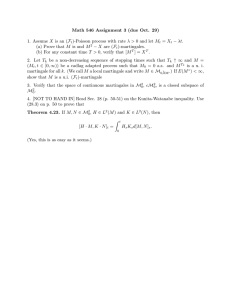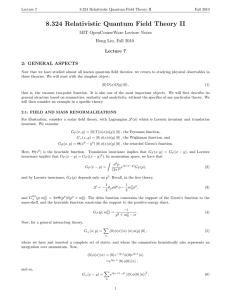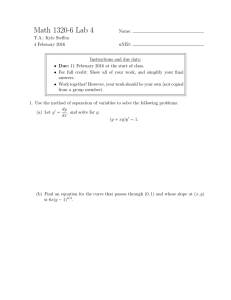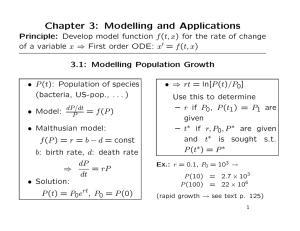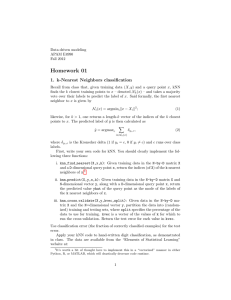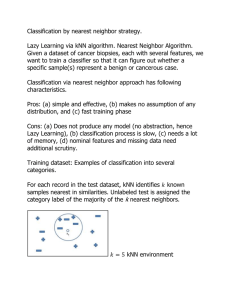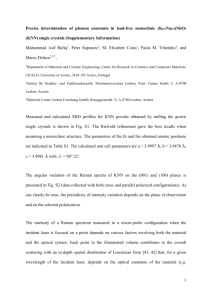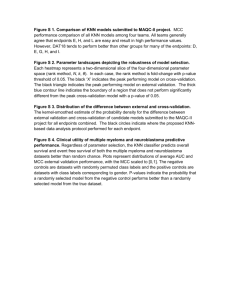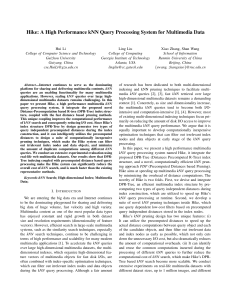Document 13650477
advertisement
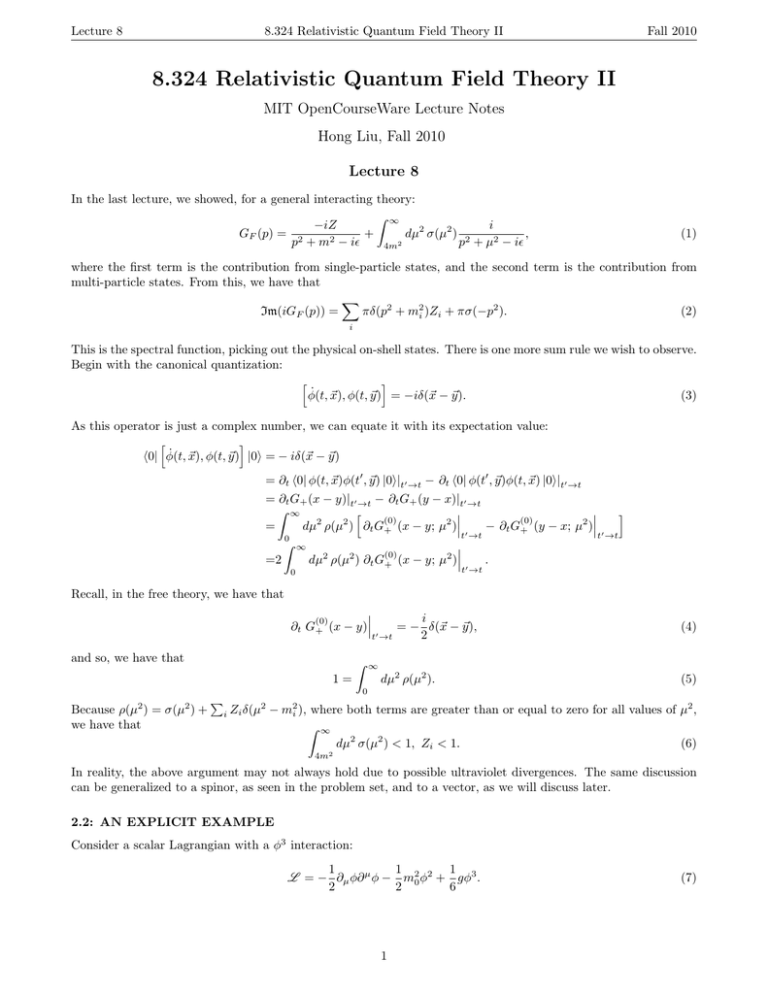
Lecture 8 8.324 Relativistic Quantum Field Theory II Fall 2010 8.324 Relativistic Quantum Field Theory II MIT OpenCourseWare Lecture Notes Hong Liu, Fall 2010 Lecture 8 In the last lecture, we showed, for a general interacting theory: ˆ ∞ −iZ i GF (p) = 2 + dµ2 σ(µ2 ) 2 , 2 p + m − iϵ p + µ2 − iϵ 4m2 (1) where the first term is the contribution from single-particle states, and the second term is the contribution from multi-particle states. From this, we have that ∑ Im(iGF (p)) = πδ(p2 + m2i )Zi + πσ(−p2 ). (2) i This is the spectral function, picking out the physical on-shell states. There is one more sum rule we wish to observe. Begin with the canonical quantization: [ ] ϕ̇(t, ⃗x), ϕ(t, ⃗y ) = −iδ(⃗x − ⃗y ). (3) As this operator is just a complex number, we can equate it with its expectation value: [ ] ⟨0| ϕ̇(t, ⃗x), ϕ(t, ⃗y ) |0⟩ = − iδ(⃗x − ⃗y ) = ∂t ⟨0| ϕ(t, ⃗x)ϕ(t′ , ⃗y ) |0⟩|t′ →t − ∂t ⟨0| ϕ(t′ , ⃗y )ϕ(t, ⃗x) |0⟩|t′ →t = ∂t G+ (x − y)|t′ →t − ∂t G+ (y − x)|t′ →t ˆ ∞ [ ] (0) (0) = dµ2 ρ(µ2 ) ∂t G+ (x − y; µ2 ) ′ − ∂t G+ (y − x; µ2 ) ′ t →t t →t 0 ˆ ∞ (0) =2 dµ2 ρ(µ2 ) ∂t G+ (x − y; µ2 ) ′ . t →t 0 Recall, in the free theory, we have that (0) ∂t G+ (x − y) and so, we have that ˆ ∞ 1= Because ρ(µ2 ) = σ(µ2 ) + we have that ∑ i t′ →t i = − δ(⃗x − ⃗y ), 2 dµ2 ρ(µ2 ). (4) (5) 0 Zi δ(µ2 − mi2 ), where both terms are greater than or equal to zero for all values of µ2 , ˆ ∞ dµ2 σ(µ2 ) < 1, Zi < 1. (6) 4m2 In reality, the above argument may not always hold due to possible ultraviolet divergences. The same discussion can be generalized to a spinor, as seen in the problem set, and to a vector, as we will discuss later. 2.2: AN EXPLICIT EXAMPLE Consider a scalar Lagrangian with a ϕ3 interaction: 1 1 1 L = − ∂µ ϕ∂ µ ϕ − m20 ϕ2 + gϕ3 . 6 2 2 1 (7) Lecture 8 8.324 Relativistic Quantum Field Theory II Fall 2010 This leads to the Feynman rules: p = −i , p2 + m2 − iϵ = ig, (8) and by dimensional analysis, we find d−2 , 2 [x] = − 1, d [g] =3 − , 2 [ϕ] = where we work in a general space-time dimension d. We note that g is dimensionless in d = 6. GF (p) = + + + + + ··· (9) Note that we do not consider diagrams involving tadpoles: ⟨0| ϕ |0⟩ ≡ ϕ0 = + ··· + (10) ˜ so that ⟨0| ϕ̃ |0⟩ = 0, and the sum of the tadpole sub­ as we can always shift the field definition to ϕ = ϕ0 + ϕ, diagrams gives zero. Now, we define 1PI, or one-particle irreducible diagrams, as the diagrams which cannot be separated into two disconnected parts by cutting one propagator. We denote the sum of 1PI diagrams by i�(p) = p = + + + + ··· , (11) and so, we have that GF (p) = + + 2 + ··· . (12) Lecture 8 8.324 Relativistic Quantum Field Theory II Fall 2010 That is, (0) (0) (0) (0) (0) (0) GF (p) =GF + GF i�GF + GF i�GF i�GF + · · · 1 (0) =GF (0) 1 − i�GF 1 =( )−1 (0) GF − i� = −i p2 + m20 − �(p) − iϵ where �(p) is the self-energy. We note that � is, in fact, a function of p2 only, by Lorentz symmetry. Before evaluating �(p2 ) explicitly to lowest order, we make two remarks: 1. The physical mass, the pole of GF (p), is given by p2 + m20 − �(p2 ) = 0. That is, the physical mass m2 satisfies m2 − m20 + �(−m2 ) = 0 (13) 2. The field renormalization Z, the residue of the pole, is given by expanding around the pole to lowest order: iGF (p)|p2 ≈−m2 = = and so Z −1 = 1 − 1 p2 + m2 − �′ (−m2 )(p2 1 p2 + m2 − iϵ 1 − + m2 ) − iϵ 1 d� dp2 2 p =−m2 , d� dp2 p2 =−m2 . We now proceed to evaluate �(p2 ) to the lowest order in g: q+p i�(p2 ) = . p (14) q Using our Feynman rules, we have ˆ 1 dd q (0) (0) i�(p2 ) = (ig)2 G (q)GF (q + p) 2 (2π)d F ˆ g2 dd q 1 = . 2 (2π)d (q 2 + m20 − iϵ)((q + p)2 + m20 − iϵ) We now evaluate the integral explicitly, using a series of tricks. Firstly, we note the identity, due to Feynman: ˆ 1 1 = dx1 · · · dxn δ(x1 + · · · + xn − 1)(n − 1)!(x1 a1 + · · · + xn an )−n . (15) a1 · · · an 0 Thus, our integrand can be rewritten as 1 = 2 2 (q + m0 − iϵ)((q + p)2 + m20 − iϵ) ˆ 1 dx 0 ˆ = 1 dx 0 1 [x((q + p)2 + m20) 2 + (1 − x)(q 2 + m02 )] 1 [(q + xp)2 + D] 2 with D = m20 +x(1−x)p2 . Next, we perform a Wick rotation. In Lorentzian signature, the integral is not convenient to evaluate, because of the poles near the integration paths. Thus, we rotate the q0 contour to the ´ imaginary ´ axis 2 along the direction shown in figure 1. So, we let q0 = iqd , and therefore q 2 = q12 +. . .+qd2 = qE , and dd q = i dd qE . 3 Lecture 8 8.324 Relativistic Quantum Field Theory II Fall 2010 Im(q) 0 Re(q) 0 Figure 1: Illustration of the Wick rotation of the variable q0 . Combining our two results, we have the self-energy in the form ˆ ˆ d ig 2 1 d qE 1 i�(p2 ) = dx 2 + D)2 . 2 0 (2π)d (qE (16) We now proceed to the final evaluation. We observe that (16) is convergent only for d < 4. We may evaluate it for d < 4, then analytically continue its value for d ≥ 4, treating d as a complex variable. We make use of the general formula ˆ d �(b − a − d2 )�(a + d2 ) −(b−a− d ) d qE (qE )a 2 . = D (17) d (2π)d (qE + D)b (4π) 2 �(b)�( d ) 2 In this case, we have b = 2, a = 0. And so, �(p2 ) = g 2 �(2 − d2 ) 2 (4π) d2 ˆ 1 dx 0 1 (m20 d + x(1 − x)p2 )2− 2 . (18) Example 1: d=3 �(p2 ) = g2 16π ˆ 1 dx 0 1 (m20 1 + x(1 − x)p2 ) 2 . (19) First, we consider the physical mass to O(g 2 ). We wish to find the solution to (13). Note that the self-energy is of order g 2 , and so the solution is given to O(g 2 ) by m2 =m20 − �(−m20 ) ˆ 1 g2 1 1 2 =m0 − dx 1 16π m0 0 (1 − x(1 − x)) 2 =m20 − g2 log 3. 16πm0 The second term is the mass renormalization due to the interaction, to lowest order. Now, we consider the field d� renormalization, Z −1 = 1 − dp , and note that again, as �(p2 ) is of order g 2 , to lowest order we have 2 p2 =−m2 Z −1 d� =1 − 2 dp p2 =−m2 0 g2 1 1 =1 − (− ) 16π 2 m30 1 = < 1, 0.23g 2 1 + 32�m3 0 4 ˆ 1 dx 0 x(1 − x) 3 (1 − x(1 − x)) 2 Lecture 8 8.324 Relativistic Quantum Field Theory II Fall 2010 where the integral in dx has been evaluated explicitly. Finally, we note that for −p2 ≥ 4m20 , we have that m20 + x(1 − x)p2 is smaller than zero for a range of x between 0 and 1. Therefore, �(p2 ) becomes complex. It is convenient to consider ˆ 1 g2 1 �(s) = dx (20) 1 16π 0 (m20 − x(1 − x)s) 2 as a function of a complex variable s, with �(p2 ) = �(s = −p2 + iϵ). �(s) has a branch point at s = 4m20 . This is precisely the multiple-particle cut predicted in the general formalism last lecture. Note that m2 = m20 + O(g 2 ). We can now understand the physical interpretation of this result: i�(p2 ) = (21) to lowest order, and when −p2 > 4m20 , both the intermediate particles can simultaneously go on-shell. Im(iGF ) = πσ(−p2 ) becomes non-zero and Im(−p2 ) is just the Feynman diagram evaluated with both the intermediate particles on shell, giving a factor of δ(p2 + m2 ) for each propagator. 5 MIT OpenCourseWare http://ocw.mit.edu 8.324 Relativistic Quantum Field Theory II Fall 2010 For information about citing these materials or our Terms of Use, visit: http://ocw.mit.edu/terms.
